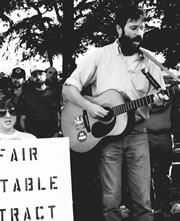Allegro
Singin’ History
The labor movement has a long and proud
Volume CX, No. 5May, 2010
 John O’Connor sings at a rally of public workers in the 1980’s |
Wherever there is a seminal event in the history of labor, there is a song. Labor – being of the people – has soul, and therefore music.
On the other hand one would be hard pressed to come up with a list of songs of Wall Street.
It is appropriate that May is Labor History Month because it is the month that the working class in most countries celebrates May Day as International Workers Day.
Though often thought of as something radical and foreign, May Day is American born, originating from the call for a general strike for the eight-hour day in 1886.
The newly founded American Federation of Labor called for the strike to begin on May 1.
Was there any singing during the mass marches and demonstrations that took place in Chicago, the movement’s epicenter?
Most likely, if there was, among the songs would have been “Hold the Fort,” a song that came to the United States from the British Transport Workers.
“Hold the Fort” was a song that was in my repertoire when I first started singing at labor functions back in the early 70’s. I was a one-man band, self-appointed labor troubadour hanging around hotel rooms where the Iowa Federation of Labor was holding its meetings and conventions, singing union songs that had strong singable choruses, counting on the attendees to keep me in loose change and beer.
It was music that brought me to the labor movement. Having been spoon-fed on the Kingston Trio and Harry Belafonte, I learned the songs of Woody Guthrie and many of the songs that came from the Appalachian coal fields. The fascination of how these songs originated led me to several histories of the American labor movement.
There I found that what I had been taught in American History class only told half the story.
Another thing I learned very quickly was that one of the most effective ways to get people interested in labor history and the culture of workers in this country was by singing songs from the vast treasure that has been handed down through the 20th century when our labor movement was trying to keep pace with industrialization.
It’s true that the Congress of Industrial Organizations paved the way in the 1930’s for the modern industrial labor movement.
But, 20 years earlier, it was the Industrial Workers of the World (the “Wobblies”) that inspired the working class with its idea of one big union and its army of poets and musicians who baptized the labor movement as a singing movement.
‘I dreamed I saw Joe Hill…’
The archetype of labor troubadours was embodied in Joe Hill, a Swedish immigrant and rebel rouser, who traveled the country in the second decade of the 20th century, lending support to union battles by making up songs to popular melodies
Joe Hill was a Wobbly, and his story is tragic and heroic. It is widely held that he was framed for murder in Utah and executed by the state on behalf of the copper industry. He’s our own mythical martyr who was immortalized through the song “Joe Hill,” made famous by Joan Baez’s rendition at Woodstock in 1969.
I’ve sung Joe Hill songs to thousands of unionists over the years, including “The Preacher and Slave,” “There is Power In A Union” and “Casey Jones, the Union Scab.”
Each song is a crystallization of a moment in history that gave voice to exploited legions of workers fighting for their rights.
Joe Hill wasn’t the only Wobbly troubadour.
Among the ranks was Ralph Chaplin, who wrote the union movement’s most widely sung song, “Solidarity Forever.”
As was the convention, this anthem of labor is set to a well-known tune, the “Battle Hymn of the Republic,” making it possible for the song to be taught instantly to any group of rallying workers.
I was drawn to these songs because they always drew great enthusiasm from unionists hearing them for the first time or the fortieth time.
Another body of songs that thrilled me was from Appalachian mineworkers.
Vying with “Solidarity Forever” for the best known labor song is “Which Side Are You On,” a song written by the wife of a union organizer in Harlan County, Kentucky.
Harlan County produced many labor singers largely due to the fact that the Appalachian people were steeped in the song and ballad tradition of their ancestors in Scotland and Ireland.
One of the first songs I learned to sing was a song called “The Coal Tattoo” by Billy Ed Wheeler. Set in a minor key that drives the strength of the lyrics, the song tells the story of a blacklisted mineworker.
As a teenager, I brought the song to a high school history class as my show and tell.
My history teacher was stunned.
He hadn’t been teaching working class history, but here was a 16-year-old, enthralled by the romance of militant miners, giving his fellow students a history lesson by simply singing a song.
John O’Connor’s song “Carpal Tunnel” can be heard on “Classic Songs of Labor,” available at www.folkways.si.edu.
